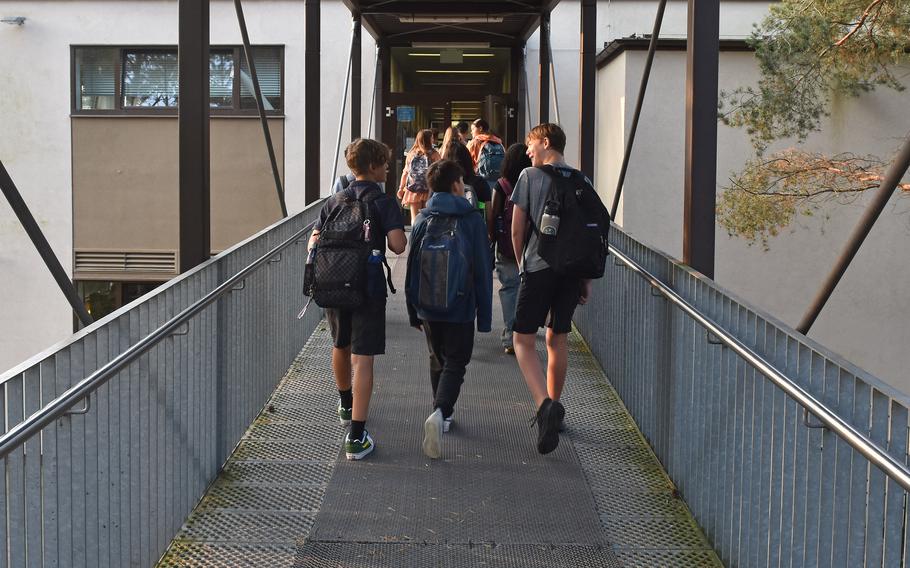
Students head to class at a Department of Defense Education Activity school in Germany in 2024. An executive order signed April 23, 2025, by President Donald Trump directs U.S. public schools, including those operated by DODEA, to end discipline policies based on racial considerations and instead make student behavior the standard. (Jennifer H. Svan/Stars and Stripes)
U.S. public schools, including those operated by the Defense Department on bases stateside and abroad, are being told by the White House to rework discipline policies that it says are based on racial considerations rather than behavior.
The mandate came in an executive order signed Wednesday by President Donald Trump and titled “Reinstating Common Sense School Discipline Policies.”
A provision applying to Department of Defense Education Activity schools gives the Pentagon chief 90 days to “issue a revised school discipline code that appropriately protects and enhances the education of the children of America’s military-service families.”
Trump’s order asserts that schools have become more dangerous by letting some student misconduct slide to avoid racial inequity in discipline numbers.
Having a disparate number of Black or Latino students suspended versus white students, for instance, could have led to scrutiny by the federal government and a loss of federal funds under the guidance of previous administrations, according to the White House.
The federal government ”will no longer tolerate known risks to children’s safety and well-being in the classroom that result from the application of school discipline based on discriminatory and unlawful ‘equity’ ideology,” the order states.
DODEA is reviewing the order and “will implement all appropriate actions” once it receives direction from the Defense Department, an agency spokeswoman said in a statement Thursday.
The order cites a 2018 report from the Federal Commission on School Safety that found “schools ignored or covered up — rather than disciplined — student misconduct in order to avoid any purported racial disparity in discipline numbers that might catch the eye of the federal government.”
At issue in the new Trump administration order is the restoration under former President Joe Biden of federal guidance saying that racial discrepancies in school discipline could be grounds for punishment.
A joint letter from the Justice and Education departments in 2014 told schools they could lose federal funding if the disciplinary policies were deemed to violate Title VI of the Civil Rights Act of 1964. That portion of the law bars discrimination by federal funding recipients.
The Biden administration’s 2023 guidance “effectively reinstated the practice of weaponizing Title VI to promote an approach to school discipline based on discriminatory equity ideology,” the executive order states.
It directs the education secretary to issue new guidance within 30 days to local and state educational agencies regarding school discipline.
And within 60 days, the department must coordinate with governors and state attorneys general on how to prevent racial discrimination in school discipline, according to the order.
In addition, the White House wants an analysis of the nature and consequences of all discipline-related investigations in American education since 2009 under Title VI. The order did not specify the significance of 2009 as a starting point.
Schools across the United States have reported increased behavioral issues since the COVID-19 pandemic, according to a July 2024 report by the National Center for Education Statistics.
In May 2024, 80% of public school leaders reported that they agree or strongly agree with the statement, “The COVID-19 pandemic and its lingering effects continue to negatively impact the behavioral development of students at my school,” according to the report.
Also In 2024, the Associated Press reported that suspension rates for Black students had dropped in the past decade, but it found that large disparities still exist after reviewing discipline data in key states.
In California, for example, the suspension rate for Black students fell from 13% in 2013 to 9% a decade later, but that was still three times higher than the suspension rate for white students, according to the AP report.